
The second Toronto Biennial of Art, postponed by several months due to Covid-19, extends its 2019 edition's concern for lakes, waterways, and their influence over how we live and interact within natural and built environments.
This year's nine-site exhibition What Water Knows, The Land Remembers (26 March–5 June 2022), addresses how notions of indigeneity, ecology, ancestry, and engagement with above ground and hidden tributaries, shape life as we move inland.
Curated by Candice Hopkins, Katie Lawson, and Tairone Bastien, the Biennial reflects on the ways we use water to 'attune ourselves to its ecologies, its adaptations, its sense of time', positing the substance as a historical archive, much like land.
The exhibition displays this vast water archive with 23 commissions scattered across the Greater Toronto Area, including works by over 36 local and international artists. Toronto being one of the world's most diverse cities, works gathered in the exhibition accordingly reflect a broad range of artists hailing from 18 places of origin.
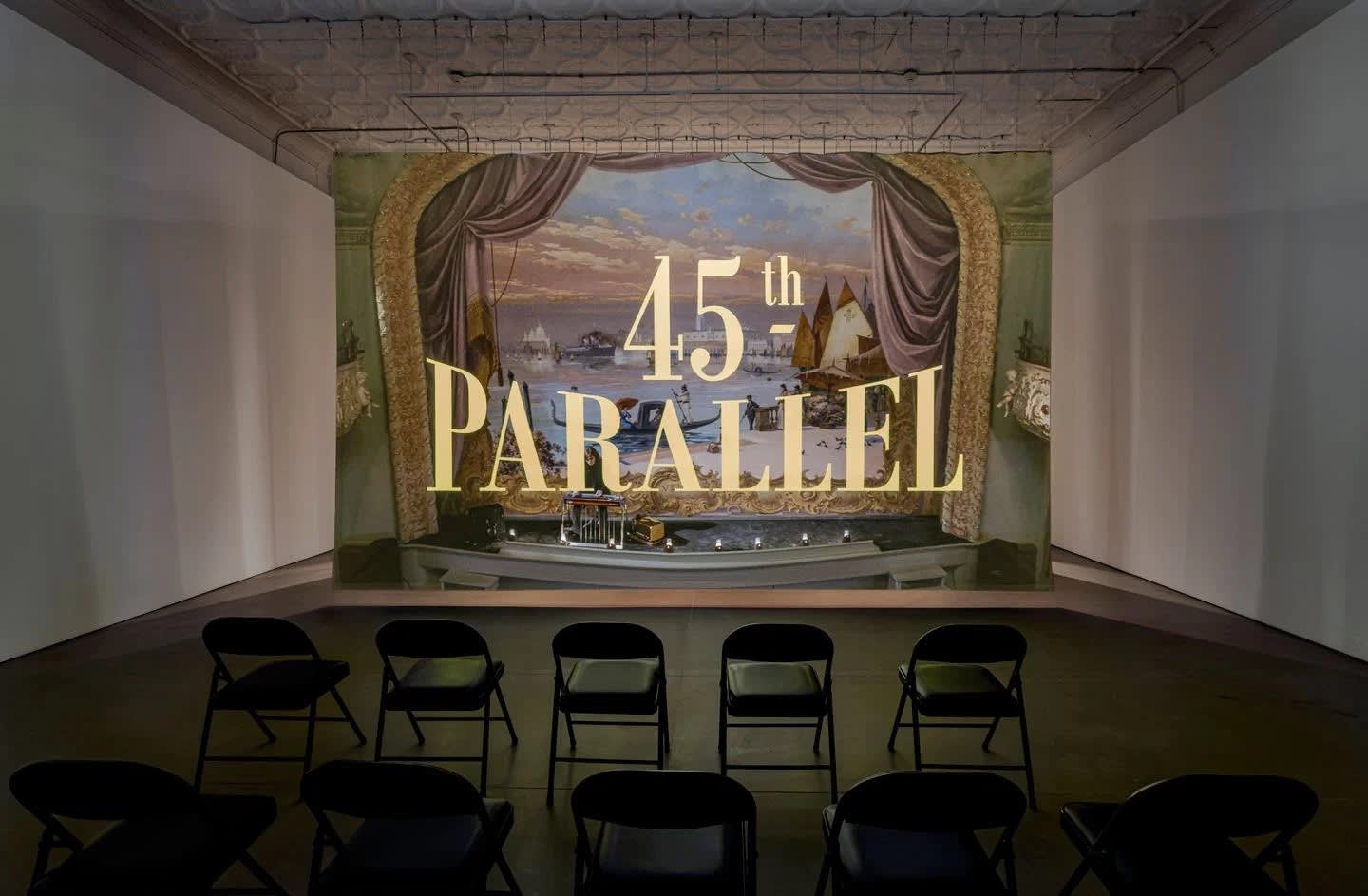
Lawrence Abu Hamdan, 45th Parallel (2022). Exhibition view: Mercer Union, Toronto Biennial of Art (26 March–5 June 2022). Courtesy the artist. Photo: Toni Hafkenscheid.
As the curatorial decidedly invokes land as a thematic focus, questions around the social and political uses of land are brought to the fore at the Mercer Union site.
There, 45th Parallel (2022), a single-channel film by Jordanian sound artist Lawrence Abu Hamdan, explores the often arbitrary and deadly idea of borders. In the film, the Haskell Free Library and Opera House, built in 1904 and situated between the U.S. and Canadian borders, is contrasted with the 2010 cross-border shooting of an unarmed 15-year-old Mexican national by U.S. border guards.
 Lawrence Abu Hamdan, 45th Parallel (2022). Exhibition view: Mercer Union, Toronto Biennial of Art (26 March–5 June 2022). Courtesy the artist. Photo: Toni Hafkenscheid.
Lawrence Abu Hamdan, 45th Parallel (2022). Exhibition view: Mercer Union, Toronto Biennial of Art (26 March–5 June 2022). Courtesy the artist. Photo: Toni Hafkenscheid.
Using visuals, performance, and sound textures, Hamdan draws attention to how land demarcations, politics, and restricted movement are bound together in ways that are both harrowing and abstract.
Moving across town, to the Junction neighbourhood's Arsenal Contemporary Art Gallery, several artworks engage with notions of land and control. In Palestinian artist Jumana Manna's film Foragers (2022), fiction, archival footage, and documentary report on so-called nature protection practices imposed by the Israeli government in Palestine and Golan Heights.
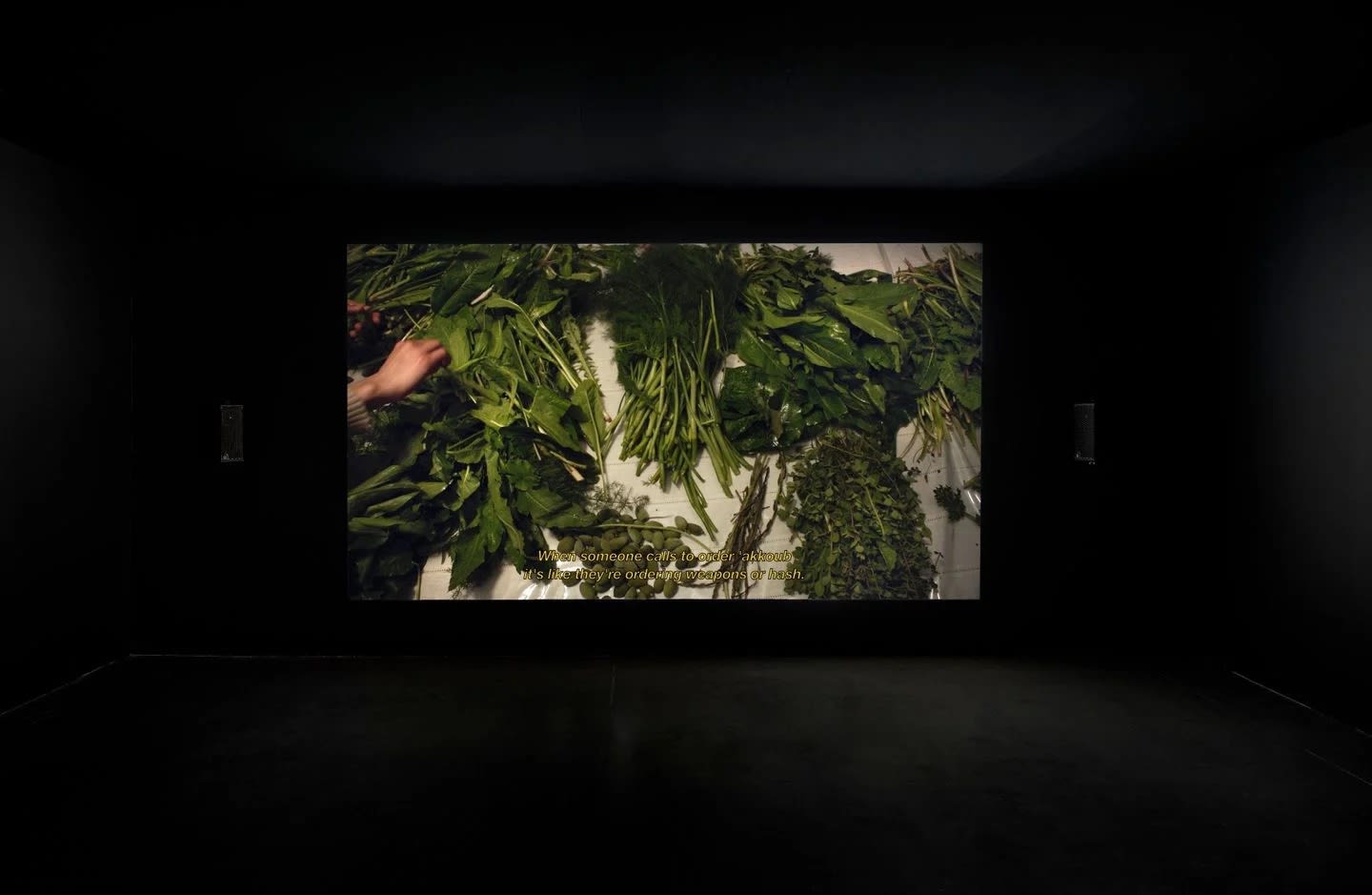 Jumana Manna, Foragers (2022). Video with audio. 65 min. Exhibition view: Arsenal Contemporary Art Toronto, Toronto Biennial of Art (26 March–5 June 2022). Co-commissioned by the Toronto Biennial of Art, Berkeley Art Museum and Pacific Film Archive, and basis voor actuele kunst. Courtesy Toronto Biennial of Art. Photo: Toni Hafkenscheid.
Jumana Manna, Foragers (2022). Video with audio. 65 min. Exhibition view: Arsenal Contemporary Art Toronto, Toronto Biennial of Art (26 March–5 June 2022). Co-commissioned by the Toronto Biennial of Art, Berkeley Art Museum and Pacific Film Archive, and basis voor actuele kunst. Courtesy Toronto Biennial of Art. Photo: Toni Hafkenscheid.
We see foragers, many elderly, being stopped, questioned, and tracked by authorities as they move through fields collecting wild plants like the much-loved akkoub (gundelia) and za'atar (thyme). With no apparent security-based reason for denying this gathering of food, the laws appear to be designed solely to separate Palestinian people from maintaining connection with the land and their traditions.
'Curated by Candice Hopkins, Katie Lawson, and Tairone Bastien, the Biennial reflects on the ways we use water to 'attune ourselves to its ecologies, its adaptations, its sense of time'...
In an adjacent exhibition space, Amazonian artist and naturalist Abel Rodríguez's film Mogaje Guihu, El nombrador de plantas / Mogaje Guihu, The plant namer (2021), made in collaboration with his son Aycoobo (Wilson Rodríguez), posits the Amazon and its thick, lush foliage as a pathway toward decentring human ways of knowing.
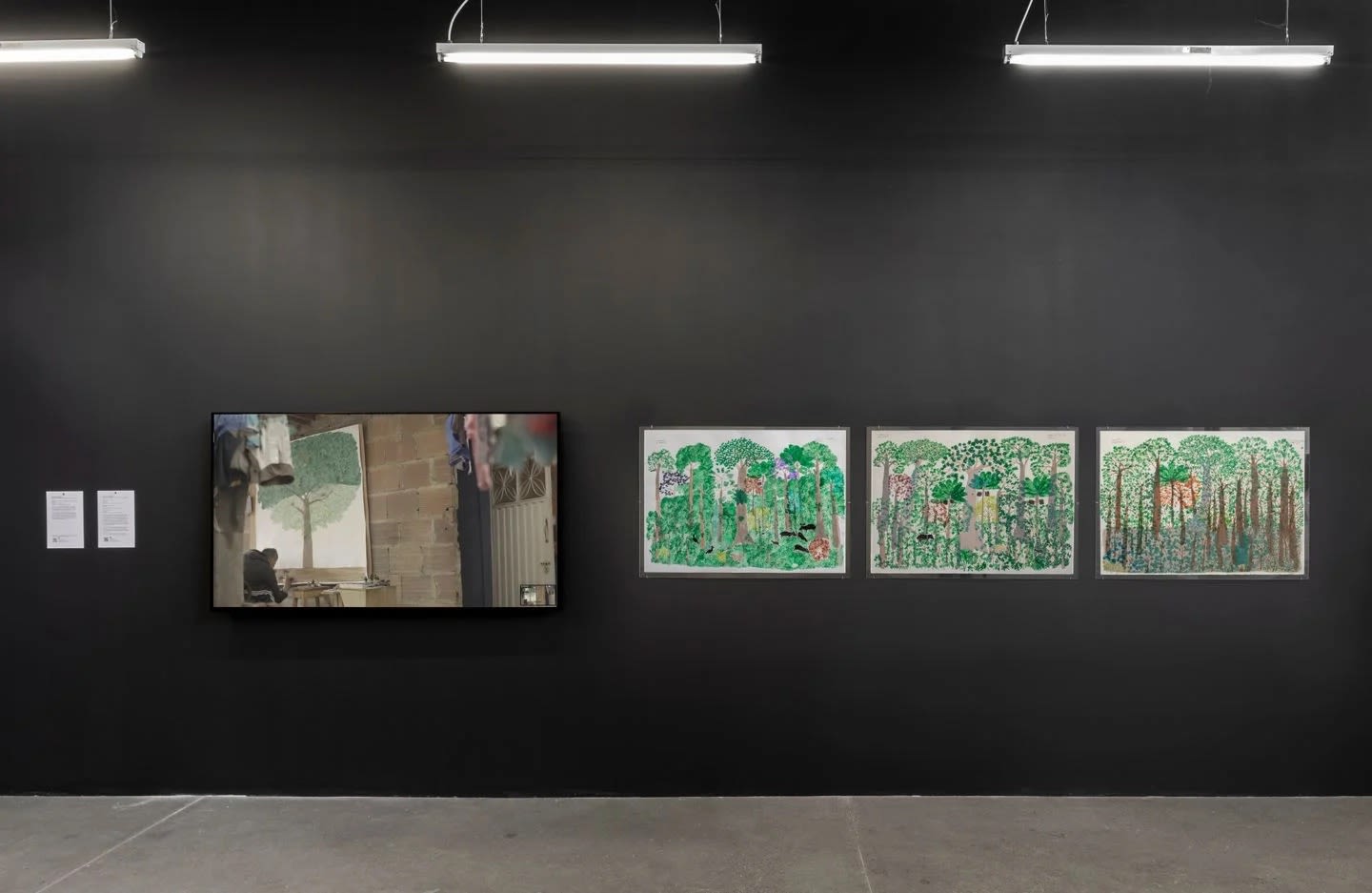
Left to right: Abel Rodríguez, Mogaje Guihu, El nombrador de plantas / Mogaje Guihu, The plant namer (2021). Single-channel documentary feature film. 50 min. Commissioned by the Toronto Biennial of Art. Made possible with the generous support of Age of Union Alliance; La vega alta no inundable; Territorio de montes firme; Tierra firme de centro (2021). All ink on paper. 70 x 100 cm. Exhibition view: Arsenal Contemporary Art Toronto, Toronto Biennial of Art (26 March–5 June 2022). Courtesy the artist and Instituto de Visión, Bogotá. Photo: Toni Hafkenscheid.
With emphasis on cross-generational knowledge, spirituality, and medicinal secrets threatened by human intrusion, Aycoobo's acrylic-on-paper drawings, 4 elementos del origen and Conexión (both 2021), show meticulous, colourful Amazon scenes that include botanical and spiritual elements, suggesting that plants may offer non-human ways of perceiving and experiencing the world.
At 72 Perth Avenue, a repurposed Pentecostal church serves as an intriguing site for works considering ideas of belief. American Ojibwe artist Andrea Carlson's sculptural installation Never-Ending Monument(2022) is a small forest comprised of wood effigy staffs referencing the prehistoric human-shaped Man Mound earthwork in Wisconsin, which had its lower legs destroyed during the building of a road.
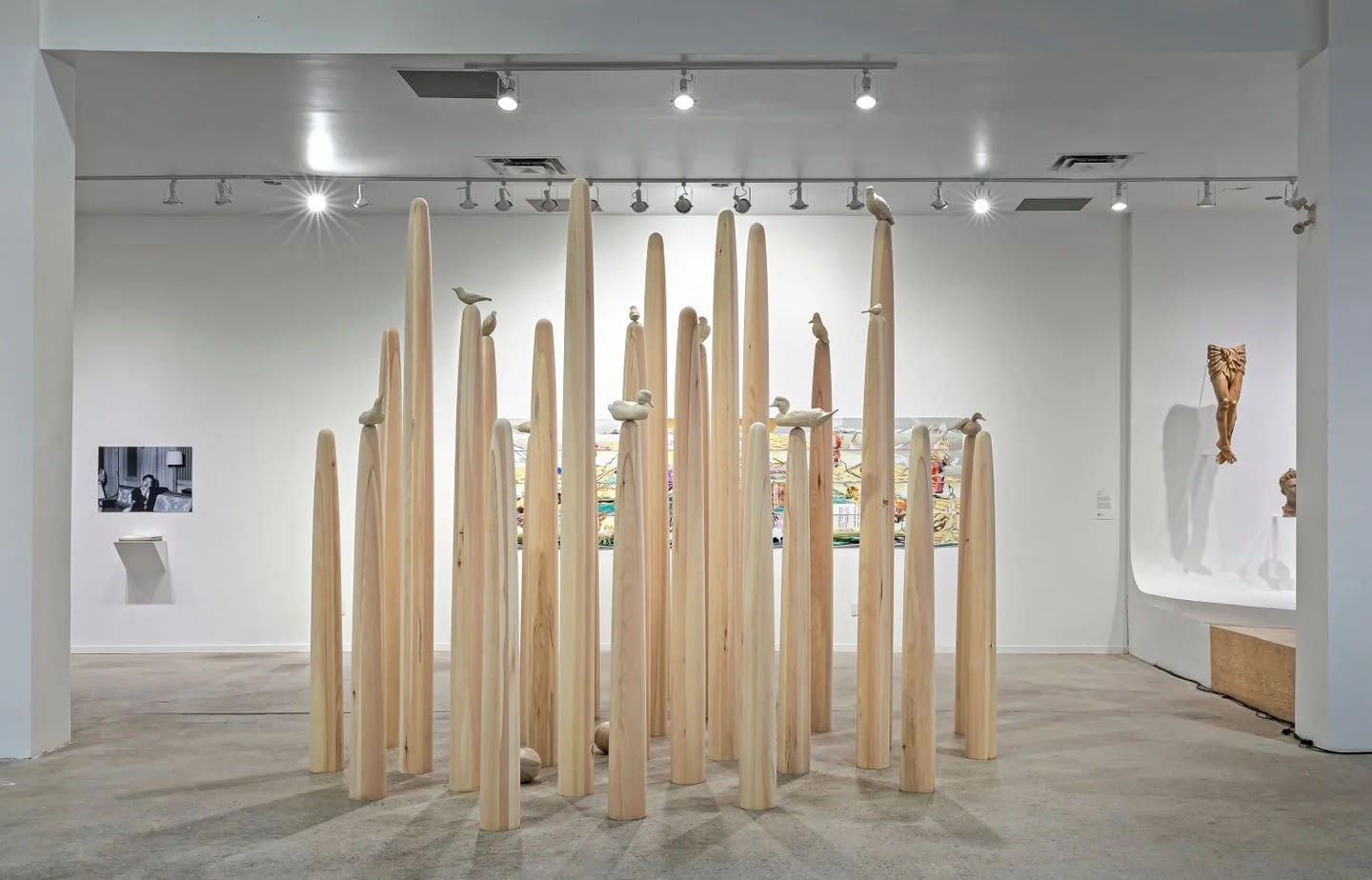 Andrea Carlson, Never-Ending Monument (2022). 28 wood columns. Exhibition view: 72 Perth Avenue, Toronto Biennial of Art (26 March–5 June 2022). Co-commissioned by the Toronto Biennial of Art and FRONT International Cleveland Triennial for Contemporary Art. Courtesy Toronto Biennial of Art. Photo: Toni Hafkenscheid.
Andrea Carlson, Never-Ending Monument (2022). 28 wood columns. Exhibition view: 72 Perth Avenue, Toronto Biennial of Art (26 March–5 June 2022). Co-commissioned by the Toronto Biennial of Art and FRONT International Cleveland Triennial for Contemporary Art. Courtesy Toronto Biennial of Art. Photo: Toni Hafkenscheid.
Such mounds were used in Late Woodland cultures to hold human remains and make symbolic connections between the natural and supernatural worlds.
In a nearby gallery, spiritual iconography is mashed up with pop culture in American artist Paul Pfeiffer's Incarnator (2018–2022), a part-sculpture, part-video installation exploring beliefs held by encarnadores, sculptors widely revered in the Philippines for their ability to make life-like renderings of Catholic icons.
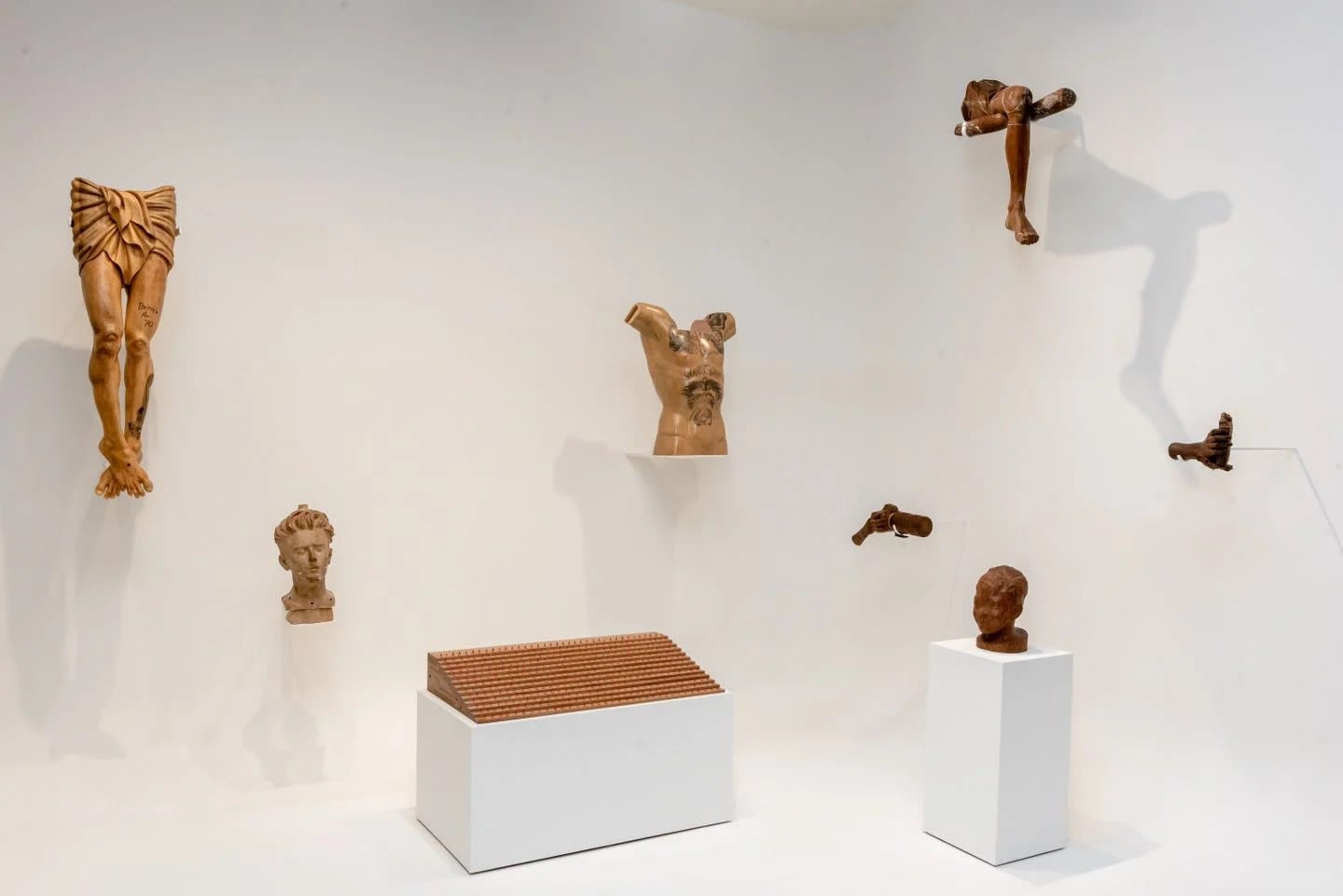
Paul Pfeiffer, Incarnator (2018–2022). Sculptural objects (Gmelina and balayong wood, paint, stainless steel, cast resin). Dimensions variable. Exhibition view: 72 Perth Avenue, Toronto Biennial of Art (26 March–5 June 2022). Courtesy the artist; carlier | gebauer, Berlin/Madrid; and Bellas Artes Outpost, Manila. Photo: Rebecca Tisdelle-Macias.
Pfeiffer's sculptures paradoxically use carvings of Justin Bieber's body to illuminate the crosscurrents between capitalism, religion, colonialism, and their ongoing impact.
Moving to the Small Arms Inspection Building, a former munitions plant where women laboured during the later war years, Diné (Navajo) artist Eric-Paul Riege's installation a home for Her (2021–2022) presents a full-scale model of his childhood home made from panels of fabric woven by women weavers in his family.
 Front to back: Dana Prieto, Footnotes for an Arsenal (2022). Terracotta tiles, terracotta containers, fired soil. Dimensions variable; Eric-Paul Riege, a home for Her (2021–2022). Mixed fibres. Exhibition view: Small Arms Inspection Building, Toronto Biennial of Art (26 March–5 June 2022). Commissioned by the Toronto Biennial of Art. Courtesy Toronto Biennial of Art. Photo: Toni Hafkenscheid.
Front to back: Dana Prieto, Footnotes for an Arsenal (2022). Terracotta tiles, terracotta containers, fired soil. Dimensions variable; Eric-Paul Riege, a home for Her (2021–2022). Mixed fibres. Exhibition view: Small Arms Inspection Building, Toronto Biennial of Art (26 March–5 June 2022). Commissioned by the Toronto Biennial of Art. Courtesy Toronto Biennial of Art. Photo: Toni Hafkenscheid.
Walking through the off-white structure, examining the intricate detail and open cuts that stand in for windows, viewers are invited to contemplate ideas of shelter, cultural inheritance, and knowledge passed on by Indigenous women.
While many of the works in the exhibition focus on efforts to maintain visible or established cultural threads, Jamaican-born artist Camille Turner's immersive multimedia installation Nave (2022) addresses knowledge that has been submerged or repressed by colonial projects.
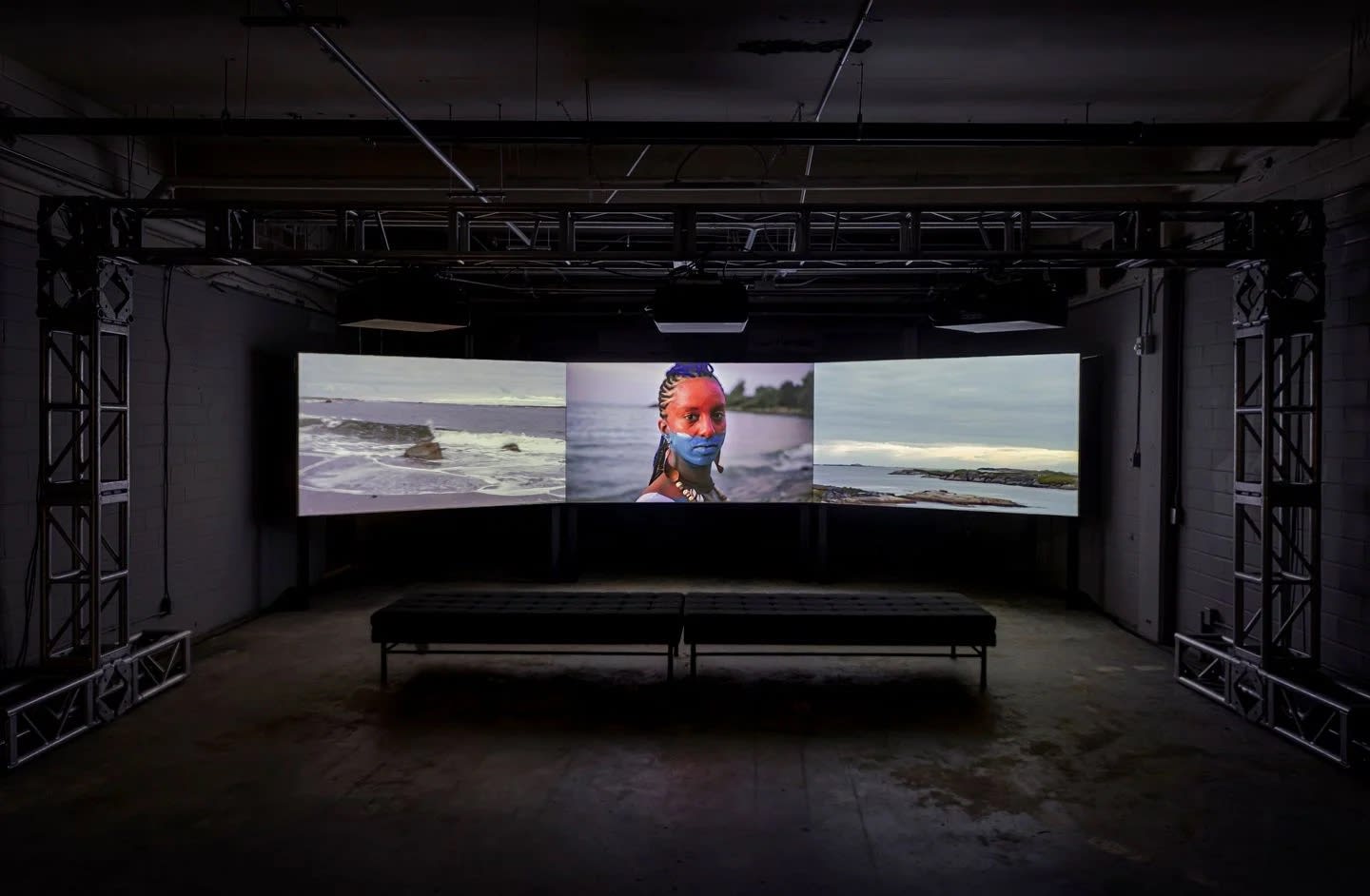 Camille Turner, Nave (2022). Three-channel video installation and soundscape. Exhibition view: Small Arms Inspection Building, Toronto Biennial of Art (26 March–5 June 2022). Commissioned by the Toronto Biennial of Art. Courtesy Toronto Biennial of Art. Photo: Toni Hafkenscheid.
Camille Turner, Nave (2022). Three-channel video installation and soundscape. Exhibition view: Small Arms Inspection Building, Toronto Biennial of Art (26 March–5 June 2022). Commissioned by the Toronto Biennial of Art. Courtesy Toronto Biennial of Art. Photo: Toni Hafkenscheid.
The three-channel video installation shows the artist performing as a time traveller moving between an empty church and a rumbling seashore, forming a visual and sonic interpretation of the historical connections between Newfoundland's shipbuilding industry and slavery during the transatlantic slave trade.
The church's nave, when looked at inversely, has the appearance of the slave ship's hold—a relationship reflecting Christianity's role in enslaving millions of Africans in the name of religion.
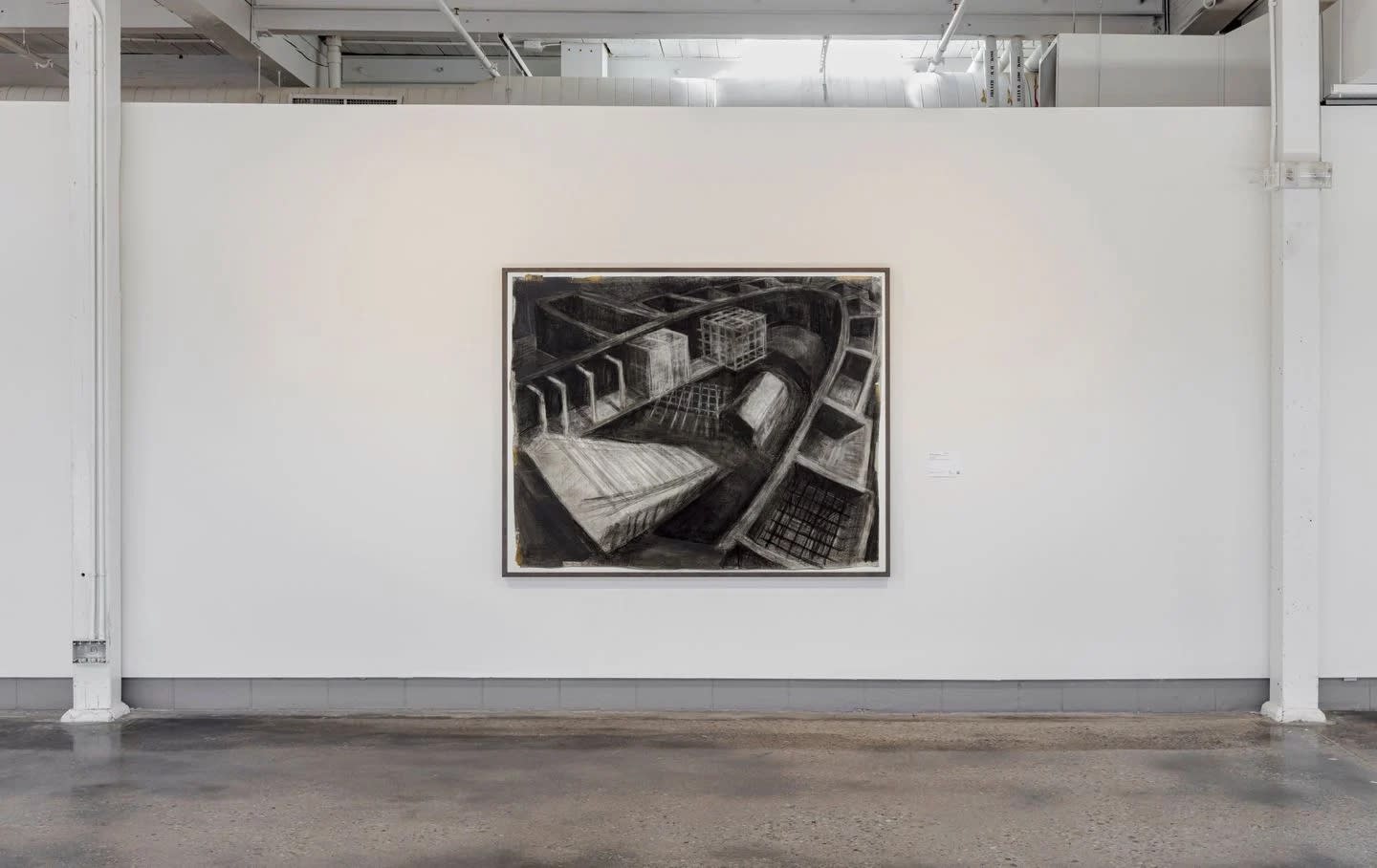
Denyse Thomasos, Untitled (late 1980s). Charcoal on paper. 149.9 x 190.5 cm. Exhibition view: Small Arms Inspection Building, Toronto Biennial of Art (26 March–5 June 2022). Commissioned by the Toronto Biennial of Art. Courtesy Toronto Biennial of Art. Photo: Toni Hafkenscheid.
On a nearby wall, Turner's installation is underscored by a series of untitled charcoal drawings from the 1980s by the late Trinidad-born artist Denyse Thomasos. Known for her bold architecture-inspired drawings, the charcoal works show cavernous container-like shapes that conjure slave ships and their claustrophobic conditions, which made breathing and movement near impossible.
Moreover, these drawings comment on how slavery has shaped Black trajectories, culminating in contemporary experiences of overincarceration and psychological trauma derived from pervasive anti-Black racism.
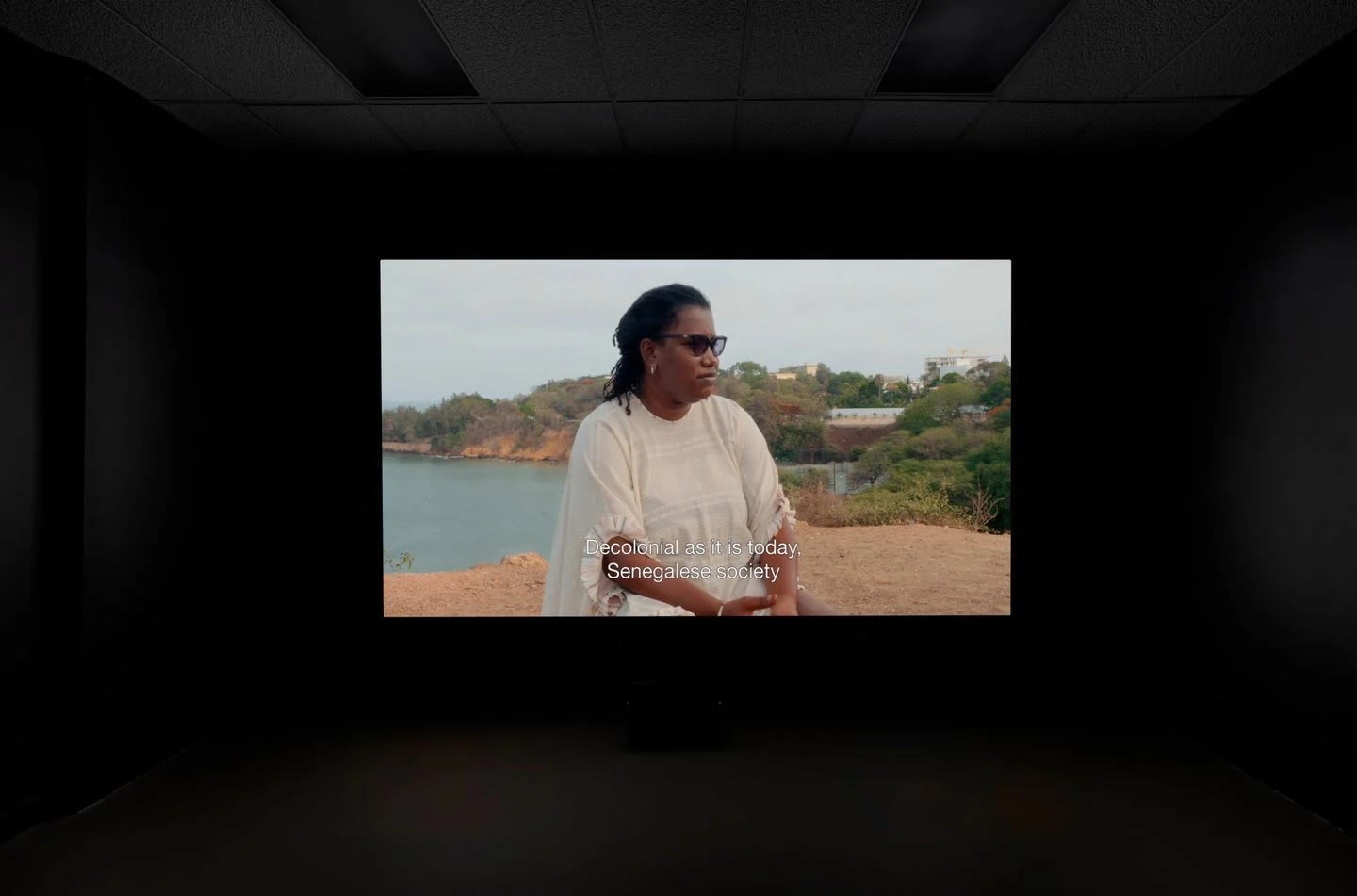
Shezad Dawood, Leviathan Cycle, Episode 7: Africana, Ken Bugul & Nemo (2022). Single-channel HD video. 14 min, 42 sec. Courtesy the artist and UBIK Productions. Commissioned by the Toronto Biennial of Art and Leviathan – Human & Marine Ecology. Exhibition view: Toronto Biennial of Art (26 March–5 June 2022). Courtesy Toronto Biennial of Art. Photo: Toni Hafkenscheid.
Keeping with the Biennial's focus on forming and sustaining curatorial communities despite the challenges, two works take on the pandemic in slightly different ways.
Dane-Zaa artist Brian Jungen's 'Plague Mask' sculptures (all 2020) are presented at 5 Lower Jarvis, not far from the city's business centre. Jungen uses recycled and reconstructed Nike Air Jordans to create masks resembling ones worn by 17th-century 'plague doctors', suggesting that commerce, mass media, and everyday consumption persist amid death and illness.

Brian Jungen, Plague Mask (2020). Nike Air Jordans. 34.3 x 68.6 x 40.6 cm. Exhibition view: 5 Lower Jarvis, Toronto Biennial of Art (26 March–5 June 2022). Courtesy Stephen Bronfman & The Claridge Collection. Photo: Toni Hafkenscheid.
In keeping with lingering concern for congregating in shared spaces, the Museum of Contemporary Art Toronto presents Choctaw-Cherokee artist Jeffrey Gibson's installation I AM YOUR RELATIVE (2022), 15 colourful and reconfigurable stages covered with text and images from local historical archives.
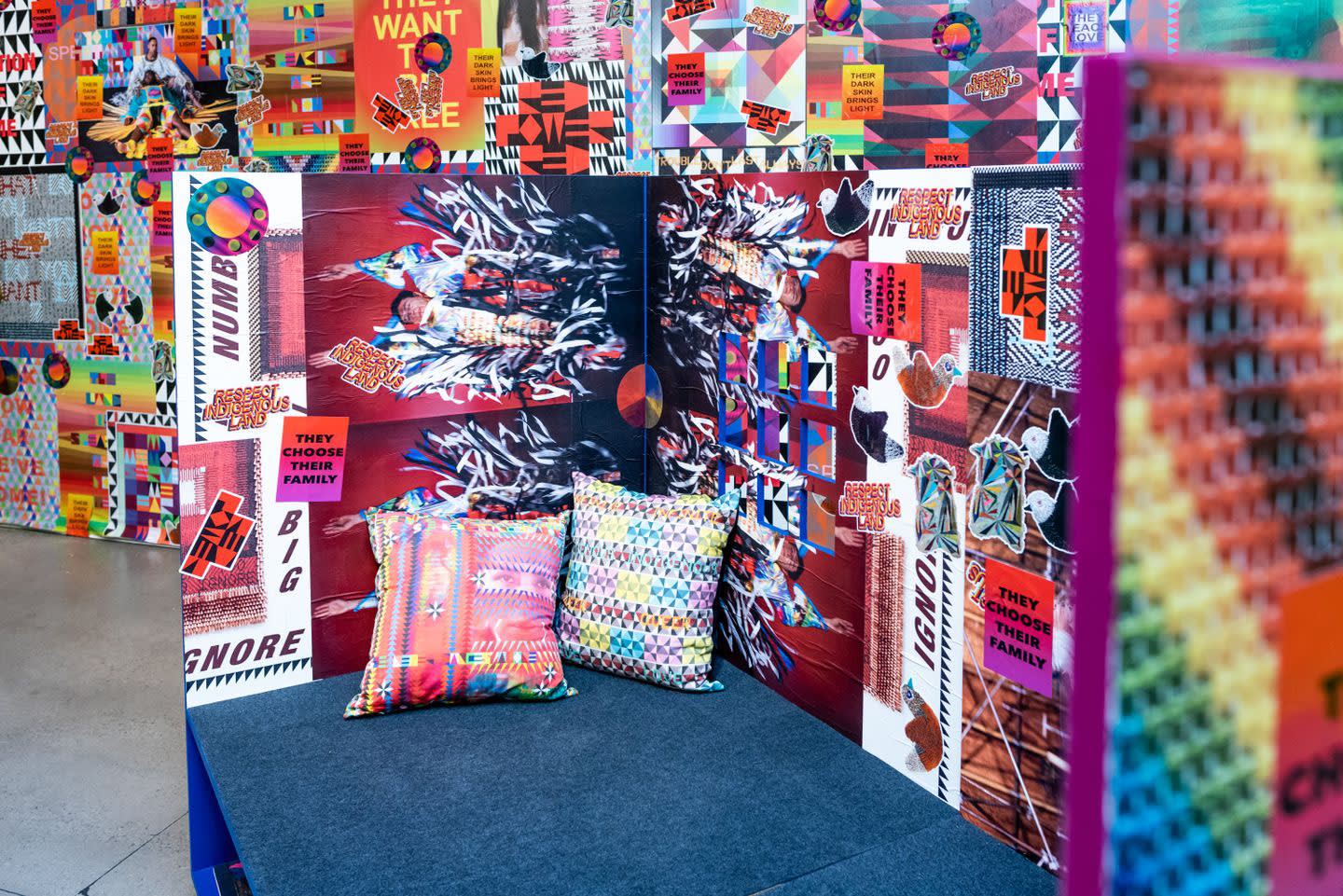
Jeffrey Gibson, I AM YOUR RELATIVE (2022). CNC-cut wood panels, paint, carpet, coasters, books, cushions, posters, stickers. Dimensions variable. Exhibition view: Museum of Contemporary Art Toronto, Toronto Biennial of Art (26 March–5 June 2022). Co-commissioned by the Toronto Biennial of Art and the Museum of Contemporary Art Toronto. Courtesy Toronto Biennial of Art. Photo: Rebecca Tisdelle-Macias.
Viewers are invited to contribute stickers to the stages, which will act as sites for talks, presentations, and discussions throughout the exhibition—a decidedly participatory and vibrant call to gather again.
Wrapping up the Toronto Biennial of Art, American artist Judy Chicago's pyrotechnic smoke-based work A Tribute to Toronto (2022) promises to explode in wild colour over Lake Ontario on 4 June, returning everything to the water. —[O]

